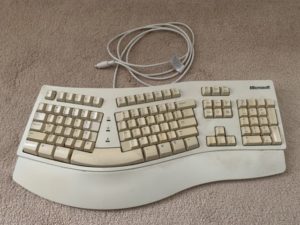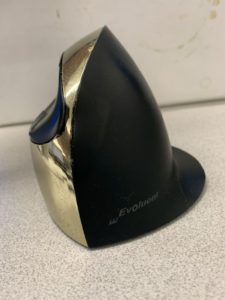Having moved off chairs, and the ergonomics of sitting comfortably, I returned to the place most people think of when they hear the word “ergonomics,” your desk. More specifically, your working area, in the form of ergonomic keyboards.
You know, one of these:

Because we think of them together, you know, “Your keyboard and mouse,” in that post I promised to talk about those two things. In my usual wordy way, I used so much space on getting your keyboard right that I had to leave mice for this week.
Ergonomic Mice
So here we go, getting your mouse selection right. It starts with the test I gave you for finding the correct anatomical position of your hand, wrist and forearm for typing. It’s the same for mousing.
Here’s the test again:
- Stand up
- Let your mouse hand’s arm dangle loosely by your sides
- Raise your mouse hand by rotating your shoulders
- Keep your wrist straight as you do so
- Let your elbow move naturally, just let them do their own thing
- Do this until your forearm is level
What is the position of your hand? That is the position your hand should be in when using your mouse.
Just as I needed that keyboard pictured above, so do I need an ergonomically designed mouse, particular to the natural position of my hand on my desktop This would be that mouse:

Which has:
- My hand is almost vertical, palm pointing to the left
- The buttons are stacked at the back
- There is a channel for the thumb with an extra button in it
This mouse is so good several of my coworkers went and got the same (or a very similar) one. The only drawback to this bad boy is that it’s wireless, and the Bluetooth signal eats batteries fast. Were I to do it over, I’d get a wired version, but that’s just me.
You don’t have to go this way, because your hands/wrists/arms aren’t the same as mine. Find a mouse that fits your particular needs and you will find that your wrists, as with a good keyboard, will thank you for it.
